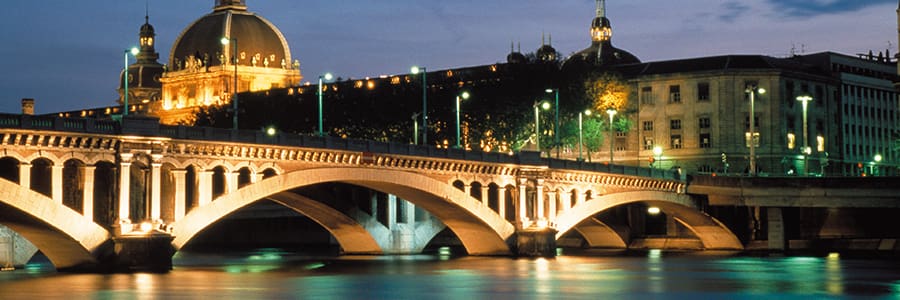
About The Saone River
The river’s name derives from that of the Gallic river goddess, Souconna.
Rising at Viomenil in the Vosges and joining the Rhone in Lyon, the Saône runs for 300 miles, much of it linked via locks and canals with the Loire, Seine, Rhine, and Marne rivers. An important waterway since the Bronze Age, the Saône has witnessed centuries of history while nurturing the epicurean riches of France’s world-famous Beaujolais region.
Most Saone River cruises run between Chalon-sur-Saône and Avignon or Arles, on the Rhone. While the scenery is lovely, it’s the food and wine that really steal the show. Lyon, considered the gastronomic capital of France, is a highlight of the trip, a UNESCO World Heritage site chock full of fascinating historical sites, museums, parks, and gourmet attractions.
Given its fame and popularity, there are many options for cruising the Saone; in addition to mini-cruises featuring just the Saône, most cruise companies offer combinations with the Rhone for a longer cruise, as well as Saône and Seine combination cruises.
Saone River Stats
Length: 294 miles
Depth: 1 to 6 feet
Source: Near Vosges, France
Mouth: Rhone River near Lyon, France
Locks: 51
Countries: France
Learn More About the Saone River of Europe
The Saône River, winding its way through the picturesque landscapes of France, is a watercourse that embodies the rich history, cultural heritage, and natural beauty of the region. Spanning approximately 480 kilometers, the Saône River flows through eastern France, serving as a vital artery that connects several cities and regions while offering a serene and picturesque environment for both locals and tourists alike. This article explores the Saône River in depth, delving into its history, ecological significance, economic importance, and the cultural treasures it has nurtured along its banks.
Geography and Course
The Saône River originates in the Vosges Mountains near Vioménil in the northeastern part of France, at an elevation of about 392 meters above sea level. It is a tributary of the mighty Rhône River, with which it converges near the city of Lyon. Along its course, the Saône flows through several important cities and regions, including Épinal, Vesoul, Gray, Chalon-sur-Saône, Mâcon, and Villefranche-sur-Saône. One of the notable features of the Saône is its relatively calm and slow-flowing nature, making it ideal for leisurely cruises and boating activities. The river’s tranquil waters meander through lush valleys and rolling hills, creating a serene atmosphere that attracts not only tourists but also wildlife, making it an essential ecological corridor in the region.
Historical Significance
The history of the Saône River dates back thousands of years. In antiquity, it was used as a vital transportation route by the Celts and the Romans, who recognized its strategic value. The river served as a key link between the Mediterranean Sea and the Rhine River, facilitating trade and cultural exchange. Numerous ancient settlements and fortifications were established along its banks, evidence of the river’s historical importance. During the Middle Ages, the Saône continued to play a crucial role in the region’s development. It was used for the transportation of goods, including timber, wine, and grains, which were essential for the local economies. The river also witnessed significant historical events, including battles and the construction of fortifications.
Ecological Significance
The Saône River is not just a historical and cultural treasure but also an important ecological corridor. Its slow-moving waters and surrounding wetlands provide vital habitat for a diverse range of plant and animal species. The river supports a variety of fish, including pike, perch, and carp, making it a popular destination for anglers. The wetlands along the Saône’s banks are home to numerous bird species, making it a birdwatcher’s paradise. Visitors can spot herons, kingfishers, and even the elusive bearded reedling in these tranquil habitats. The river’s ecosystem is a testament to the importance of preserving natural spaces within an urbanized landscape.
Economic Importance
Throughout its history, the Saône River has been a critical factor in the economic development of the regions it traverses. Today, it remains an essential transportation route for both cargo and tourism. Barges and cargo ships navigate its waters, transporting goods such as grain, petroleum, and construction materials. This transportation network reduces the strain on roadways and contributes to the efficient movement of goods within the country. Tourism is also a significant economic driver along the Saône River. Visitors are drawn to the region for its scenic beauty, charming villages, and historic sites. River cruises are a popular way to explore the Saône, allowing tourists to relax and enjoy the breathtaking landscapes while visiting cities like Lyon, Chalon-sur-Saône, and Macon.
Cultural Treasures
The Saône River has nurtured a wealth of cultural treasures along its banks. Historic towns and cities with well-preserved architecture showcase the region’s rich heritage. Chalon-sur-Saône, for example, boasts a beautifully preserved medieval old town, while Lyon, often referred to as the “Capital of the Gaules,” offers a blend of Roman and Renaissance architecture. The river has also inspired artists and writers over the centuries. Its tranquil waters and scenic vistas have been the subject of countless paintings and poems, capturing the essence of its beauty and serenity. The works of famous artists like Gustave Courbet and Paul Cézanne have celebrated the Saône’s enchanting landscapes.
Challenges and Conservation
While the Saône River is undoubtedly a valuable asset to the region, it faces several challenges in the modern era. Water quality and pollution remain concerns, as industrial and agricultural activities can impact the river’s health. Conservation efforts are ongoing to protect the river’s ecosystem and maintain its status as a thriving natural habitat. Additionally, the management of water levels and flood prevention is a priority along the Saône. The river has experienced devastating floods in the past, prompting the construction of levees and other flood control measures to protect nearby communities.
